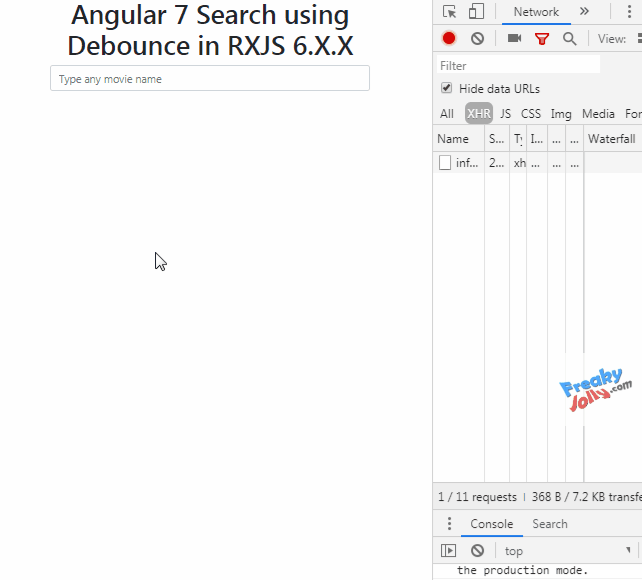针对RC.5更新
使用Angular 2,我们可以debounceTime()在窗体控件的valueChanges可观察对象上使用RxJS运算符进行反跳:
import {Component} from '@angular/core';
import {FormControl} from '@angular/forms';
import {Observable} from 'rxjs/Observable';
import 'rxjs/add/operator/debounceTime';
import 'rxjs/add/operator/throttleTime';
import 'rxjs/add/observable/fromEvent';
@Component({
selector: 'my-app',
template: `<input type=text [value]="firstName" [formControl]="firstNameControl">
<br>{{firstName}}`
})
export class AppComponent {
firstName = 'Name';
firstNameControl = new FormControl();
formCtrlSub: Subscription;
resizeSub: Subscription;
ngOnInit() {
// debounce keystroke events
this.formCtrlSub = this.firstNameControl.valueChanges
.debounceTime(1000)
.subscribe(newValue => this.firstName = newValue);
// throttle resize events
this.resizeSub = Observable.fromEvent(window, 'resize')
.throttleTime(200)
.subscribe(e => {
console.log('resize event', e);
this.firstName += '*'; // change something to show it worked
});
}
ngDoCheck() { console.log('change detection'); }
ngOnDestroy() {
this.formCtrlSub.unsubscribe();
this.resizeSub .unsubscribe();
}
}
Plunker
上面的代码还包括一个如何限制窗口调整大小事件的示例,如@albanx在下面的注释中所要求的。
虽然上面的代码可能是这样做的Angular方式,但效率不高。每次击键和每次调整大小事件(即使它们被去抖和抑制)都将导致更改检测运行。换句话说,去抖动和节流不影响更改检测运行的频率。(我发现Tobias Bosch 在GitHub上发表的评论对此进行了确认。)您可以在运行插入器时看到此消息,并ngDoCheck()在键入输入框或调整窗口大小时看到被调用了多少次。(使用蓝色的“ x”按钮在单独的窗口中运行导航按钮,以查看调整大小事件。)
一种更有效的技术是在Angular的“区域”之外,根据事件自己创建RxJS Observable。这样,每次事件触发时都不会调用更改检测。然后,在您的订阅回调方法中,手动触发更改检测-即,您控制何时调用更改检测:
import {Component, NgZone, ChangeDetectorRef, ApplicationRef,
ViewChild, ElementRef} from '@angular/core';
import {Observable} from 'rxjs/Observable';
import 'rxjs/add/operator/debounceTime';
import 'rxjs/add/operator/throttleTime';
import 'rxjs/add/observable/fromEvent';
@Component({
selector: 'my-app',
template: `<input #input type=text [value]="firstName">
<br>{{firstName}}`
})
export class AppComponent {
firstName = 'Name';
keyupSub: Subscription;
resizeSub: Subscription;
@ViewChild('input') inputElRef: ElementRef;
constructor(private ngzone: NgZone, private cdref: ChangeDetectorRef,
private appref: ApplicationRef) {}
ngAfterViewInit() {
this.ngzone.runOutsideAngular( () => {
this.keyupSub = Observable.fromEvent(this.inputElRef.nativeElement, 'keyup')
.debounceTime(1000)
.subscribe(keyboardEvent => {
this.firstName = keyboardEvent.target.value;
this.cdref.detectChanges();
});
this.resizeSub = Observable.fromEvent(window, 'resize')
.throttleTime(200)
.subscribe(e => {
console.log('resize event', e);
this.firstName += '*'; // change something to show it worked
this.cdref.detectChanges();
});
});
}
ngDoCheck() { console.log('cd'); }
ngOnDestroy() {
this.keyupSub .unsubscribe();
this.resizeSub.unsubscribe();
}
}
Plunker
我使用ngAfterViewInit()而不是ngOnInit()确保inputElRef已定义。
detectChanges()将对此组件及其子组件运行更改检测。如果您希望从根组件运行更改检测(即运行完整的更改检测检查),请ApplicationRef.tick()改用。(我ApplicationRef.tick()在插件的注释中打了个电话。)请注意,tick()将导致ngDoCheck()被调用。
